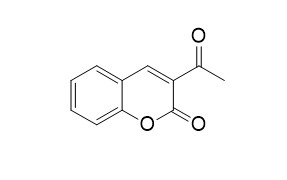3-Acetylcoumarin
3-Acetylcoumarin as a practical ligand for copper-catalyzed CN coupling reactions at room temperature. 3-Acetylcoumarin has neuroprotective,and acaricidal properties.
Inquire / Order:
manager@chemfaces.com
Technical Inquiries:
service@chemfaces.com
Tel:
+86-27-84237783
Fax:
+86-27-84254680
Address:
1 Building, No. 83, CheCheng Rd., Wuhan Economic and Technological Development Zone, Wuhan, Hubei 430056, PRC
Providing storage is as stated on the product vial and the vial is kept tightly sealed, the product can be stored for up to
24 months(2-8C).
Wherever possible, you should prepare and use solutions on the same day. However, if you need to make up stock solutions in advance, we recommend that you store the solution as aliquots in tightly sealed vials at -20C. Generally, these will be useable for up to two weeks. Before use, and prior to opening the vial we recommend that you allow your product to equilibrate to room temperature for at least 1 hour.
Need more advice on solubility, usage and handling? Please email to: service@chemfaces.com
The packaging of the product may have turned upside down during transportation, resulting in the natural compounds adhering to the neck or cap of the vial. take the vial out of its packaging and gently shake to let the compounds fall to the bottom of the vial. for liquid products, centrifuge at 200-500 RPM to gather the liquid at the bottom of the vial. try to avoid loss or contamination during handling.
Nutrients.2018, 10(12):E1998
Molecules.2020, 25(21):5091.
Pharmaceutics.2023, 15(9):2355.
Nutrients.2024, 16(14):2267.
Arch Biochem Biophys.2018, 644:93-99
Agronomy2020, 10(10),1489
J Agric Food Chem.2024,72(37):20396-20409.
Korean J. Food Preserv.2023, 30(4):663-668.
J Med Food.2021, 24(3):209-217.
J Med Assoc Thai2024, P-04.
Related and Featured Products
Chinese Journal of Pesticide ence, 2016.
Study on acaricidal bioactivity and quantitative structure activity relationship of coumarin compounds against Tetranychus cinnabarinus Bois.(Acari: Tetranychidae).[Reference:
WebLink]
METHODS AND RESULTS:
The acaricidal bioactivities of 25 representative coumarin compounds were evaluated by slide-dip method and a quantitative structure-activity relationship(QSAR) model with strong predictive ability was established. The acaricidal assay results showed that all the tested compounds exhibited high contact activity against Tetranychus cinnabarinus and the contact activity increased with prolongation of treatment time. The 48 h LC_(50) values of 8 compounds [3-(2-benzimidazolyl)-7-(diethylamino)coumarin(1), 3-(2- benzothiazolyl)-7-(diethylamino)coumarin(2), 3-aminocoumarin(3), 3-Acetylcoumarin(4), 4- methoxycoumarin(5), 6-nitrocoumarin(8), 6,7-dimethoxy coumarin(13), 7,8-dihydroxy- coumarin(21)] were less than 1 000 mg/L. The acaricidal activities of compouds 1, 2, 3, 5and 13 were higher or comparable to 98.32% spirodiclofen TC. The 48 h and 72 h LC_(50) values of the compound with the highest acaricidal activity(13) were 284.8 and 122.2 mg/m L respectively. The acaricidal activity against T. cinnabarinus of compound 13 was two fold higher than that of spirodiclofen. 34 physicochemical parameters of the above mentioned 25 coumarin compounds were calculated and used to build a QSAR model. SPSS Stepwise Regression analysis method was applied,without correlation and correcting.
CONCLUSIONS:
And the Stretch-Bend Dipole, Dipole, Total Energy and Molecular Radius were taken as independent variables in the model. This model has a strong predictive ability with R = 0.987, R2 = 0.967 and F = 155.176.
European Journal of Medicinal Chemistry, 2016,121(4):803-809.
Thiosemicarbazone modification of 3-acetyl coumarin inhibits Aβ peptide aggregation and protect against Aβ-induced cytotoxicity.[Reference:
WebLink]
Aggregation of amyloid β peptide (Aβ) is an important event in the progression of Alzheimer's disease. Therefore, among the available therapeutic approaches to fight with disease, inhibition of Aβ aggregation is widely studied and one of the promising approach for the development of treatments for Alzheimer's disease. Thiosemicarbazone compounds are known for their variety of biological activities. However, the potential of thiosemicarbazone compounds towards inhibition of Aβ peptide aggregation and the subsequent toxicity is little explored.
METHODS AND RESULTS:
Herein, we report synthesis and x-ray crystal structure of novel compound 3-Acetylcoumarin thiosemicarbazone and its efficacy toward inhibition of Aβ(1-42) peptide aggregation. Our results indicate that 3-Acetylcoumarin thiosemicarbazone inhibits Aβ(1-42) peptide aggregation up to 80% compared to the parent 3-Acetylcoumarin which inhibits 52%. Further, 3-acetyl coumarin thiosemicarbazone provides neuroprotection against Aβ-induced cytotoxicity in SH-SY5Y cell line.
CONCLUSIONS:
These findings indicate that thiosemicarbazone modification renders 3-Acetylcoumarin neuroprotective properties.
Synthesis,2010(08):1280-1284.
3-Acetylcoumarin as a PracticalLigand for Copper-Catalyzed C-N Coupling Reactions at RoomTemperature.[Reference:
WebLink]
METHODS AND RESULTS:
The use of coumarin-based ligands was examined in copper-catalyzed C-N cross-coupling reactions. It was found that 3-Acetylcoumarin constituted a new, practical ligand for the copper-catalyzed N-arylation of aliphatic amines and imidazole with aryl iodides at room temperature. Aryl bromides could also be aminated efficiently at 80 degrees C.
CONCLUSIONS:
This readily available catalyst system, namely copper(I) iodide and 3-Acetylcoumarin, provides a mild and practical method for the synthesis of aromatic amines.



